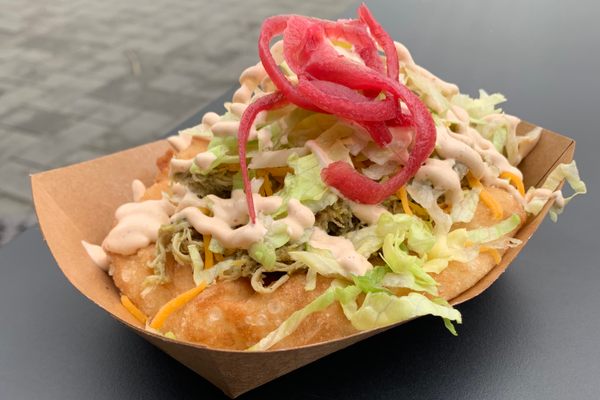Cooking Creatively With J. Kenji López-Alt
The author of ‘The Food Lab’ shares his science-based kitchen techniques and current food quest.
This article is adapted from the December 7, 2024, edition of Gastro Obscura’s Favorite Things newsletter. You can sign up here.
For many home cooks, The Food Lab: Better Home Cooking Through Science by J. Kenji López-Alt carries a level of authority traditionally reserved for sacred texts. It’s less of a cookbook and more a crash course in culinary technique. It’s also an invitation to get creative.
The 958-page tome, which came out in 2015, challenged a lot of conventional culinary wisdom. Want better scalloped potatoes? Stand the wafer-thin slices vertically, so that burnished, browned top sports hundreds of crispy edges. Want to make better pizza in a home oven? Crank up your broiler. Want to make better lasagna? Skip boiling the noodles and try adding gelatin and anchovies.
López-Alt has a gift for breaking down food science in a way that feels accessible, without ever dumbing things down. That quality has made him into a trusted culinary guru, the star of a successful YouTube series, the Chief Culinary Advisor for Serious Eats, and a regular cooking columnist for the New York Times.
When it came out, The Food Lab won a James Beard Award and an IACP Award. And just last month, it sold its millionth copy. It’s the rare cookbook that doesn’t just teach you recipes, but rather give you the confidence and the skills to improvise successfully.
Gastro Obscura spoke with López-Alt about his current food quest, why you should cook your steaks with a Home Depot blowtorch, and how his personal cooking style has evolved.
What’s one stupid easy trick I can use to make my cooking taste more like restaurant food?
One of the big differences between the way people cook in a restaurant versus at home is the quality of the stock. A homemade stock is going to be really rich in gelatin, whereas a store-bought stock has virtually none. You hear chefs say to reduce a stock down until it becomes a demi-glace. When I was a young cook and I didn’t really know much, I was trying to do this with store-bought stock and that doesn’t work. The actual thing that thickens and makes for a really silky, luxurious, well-emulsified sauce isn’t in there.
A trick that I frequently use at home is to add unflavored gelatin powder directly to store-bought stock. I just keep straight-up Knox Gelatin [in my pantry]. It’s one of the most used ingredients in my kitchen that I rarely see in anybody else’s kitchen. That will convert it not quite into a restaurant-quality stock, but it will allow it to perform all those functions. So it’ll give it that viscosity when you make a soup with it or when you reduce it down.
Say you’re making even something as simple as a ragù Bolognese or a chili. Store-bought stock is going to give it some more flavor, but it’s going to make it taste almost watery. You’ll find also that the fat that renders out tends to float at the top. Whereas when you properly emulsify and when you have a stock thickened properly with gelatin, the fat doesn’t form that layer. [The dish] becomes a richer, tastier thing.

What about replicating restaurant equipment in my tiny apartment kitchen? Let’s say I want to make a really great steak…
When they cook a steak for you at a place like, say, Peter Luger’s or one of those classic New York or Chicago steakhouses, they’re cooking on these really hot grills or under a really hot salamander. Part of that flavor is literally burning the meat, which is harder for you to do.
For things like that, I use a torch—and not a crème brûlée kitchen torch. I’ll use an actual butane or a propane torch that you buy at Home Depot, as opposed to Williams Sonoma.
When you’re searing a steak, you can point a torch at it. You heat it from both sides at the same time, so that you get that heat from the pan, but you’re also getting some of that flame that you would get from a more traditional steakhouse.
Are you on any particular food quests or missions at the moment?
I’ve been on a quest to go to every teriyaki joint in Seattle. What Americans think of chicken teriyaki, that’s a dish that was created in Seattle. I think of it as the Seattle equivalent of New York’s pizza, where in every neighborhood, you’re not more than a couple of blocks away from a teriyaki joint. It’s a cheap, dependable thing that everyone has.
Pre-pandemic, there were over 100 [teriyaki joints] in Seattle alone—not counting the suburbs or the East Side or anything. Now, I think there’s like 86. But, yeah, so my goal has been to go to every single teriyaki joint. Eventually, I do plan on working on my own recipe based on all that research. So far I’ve documented going to 25 of them.
What do you look for in great teriyaki chicken?
One of the big things is how long it’s been marinated. Sometimes you’ll find places that don’t marinate at all, and the chicken ends up a little bit stringy or the flavor is not very deep. Sometimes you’ll find places that marinate too long, and the chicken ends up getting a ham-like texture to it.
A lot of it comes down to the flavor of the sauce. Oftentimes, it can be sickly sweet as opposed to balanced. It also needs to be freshly cooked chicken. Sometimes places will cook it, cut it, and then hold it in a steam table like the way Chipotle does, and that’s the worst.
Getting a real good contrast between the dark crispy bits on the chicken and the juicy interior. That’s the real thing, the texture. So I want crunchy dark bits on the outside and then the really melt-in-your-mouth juiciness on the inside.
Dark meat or white meat?
It’s all dark meat. Skinless thighs are the standard.

What’s the origin story there?
It was invented by a guy named Toshi Kasahara. He’s in his late seventies now and he still cooks. At some point, he sold his name and franchised. Eventually, that franchise closed, but a lot of these places just kept the name. There’s a whole bunch of unassociated places that are called Toshi’s Teriyaki, but Toshi himself is still at his location. You can go buy teriyaki directly from the guy who invented it.
Teriyaki as a concept, of course, is Japanese. Teriyaki in Japan is typically more of a fish thing. There is chicken teriyaki in Japan as well, but what we think of as chicken teriyaki is boneless, skinless chicken thighs, grilled, and served on a bed of rice, usually with some slaw or salad on the side.
That whole presentation, the style of cooking, the size of the chicken, and the specific flavor profile of the sauce is not something you find in Japan. It’s a purely American thing that was invented in Seattle.
How would you say your philosophy on cooking has evolved in the decade since working on The Food Lab?
I think of [recipes] as snapshots of works in progress. So honestly, none of the recipes in The Food Lab are ones that I have used as written since writing The Food Lab. When I cook, I cook with a much freer style, where I rely on techniques and science to inform how I’m cooking.
I want people to make their home cooking more personal to them. I don’t want people copying the same recipe that everyone else is making. It’s like, you make this recipe and it can taste great, and that’s great.
But your family is a little bit different than everyone else’s family, or your priorities are different than everyone else’s. So here’s a framework for how you can take these recipes and make them your own.
This conversation has been edited for length and clarity.
Gastro Obscura covers the world’s most wondrous food and drink.
Sign up for our regular newsletter.





































Follow us on Twitter to get the latest on the world's hidden wonders.
Like us on Facebook to get the latest on the world's hidden wonders.
Follow us on Twitter Like us on Facebook